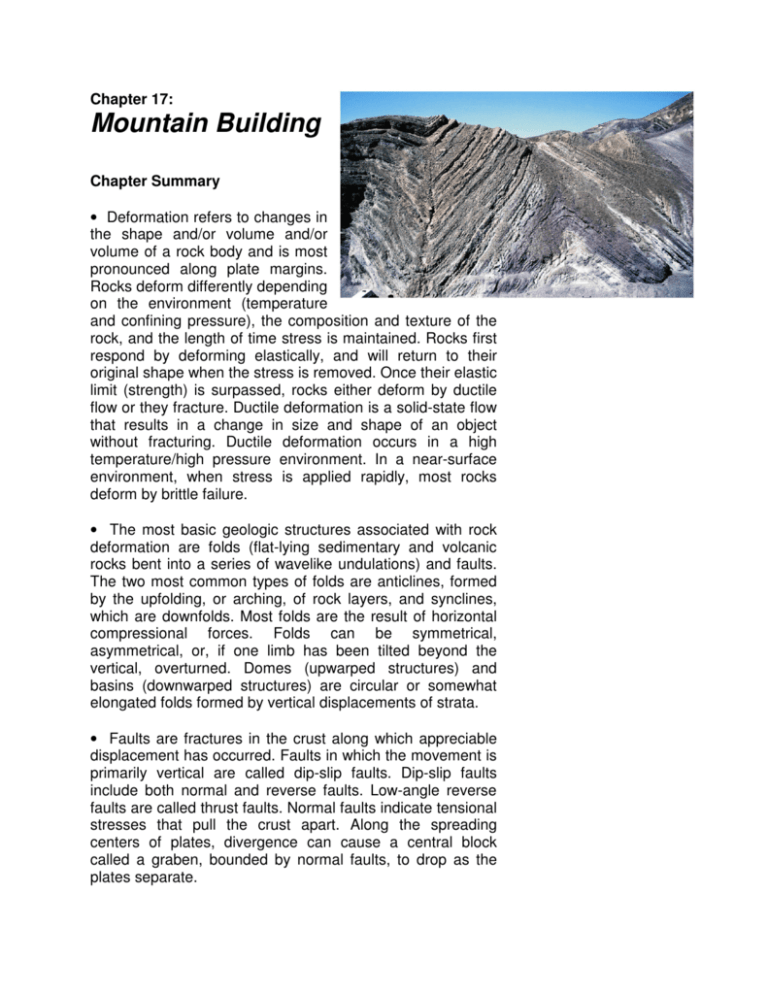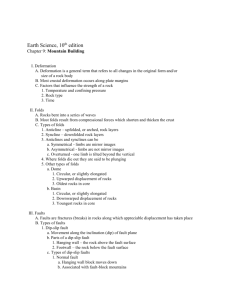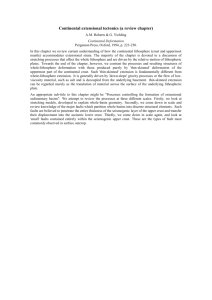Mountain Building
advertisement

Chapter 17: Mountain Building Chapter Summary • Deformation refers to changes in the shape and/or volume and/or volume of a rock body and is most pronounced along plate margins. Rocks deform differently depending on the environment (temperature and confining pressure), the composition and texture of the rock, and the length of time stress is maintained. Rocks first respond by deforming elastically, and will return to their original shape when the stress is removed. Once their elastic limit (strength) is surpassed, rocks either deform by ductile flow or they fracture. Ductile deformation is a solid-state flow that results in a change in size and shape of an object without fracturing. Ductile deformation occurs in a high temperature/high pressure environment. In a near-surface environment, when stress is applied rapidly, most rocks deform by brittle failure. • The most basic geologic structures associated with rock deformation are folds (flat-lying sedimentary and volcanic rocks bent into a series of wavelike undulations) and faults. The two most common types of folds are anticlines, formed by the upfolding, or arching, of rock layers, and synclines, which are downfolds. Most folds are the result of horizontal compressional forces. Folds can be symmetrical, asymmetrical, or, if one limb has been tilted beyond the vertical, overturned. Domes (upwarped structures) and basins (downwarped structures) are circular or somewhat elongated folds formed by vertical displacements of strata. • Faults are fractures in the crust along which appreciable displacement has occurred. Faults in which the movement is primarily vertical are called dip-slip faults. Dip-slip faults include both normal and reverse faults. Low-angle reverse faults are called thrust faults. Normal faults indicate tensional stresses that pull the crust apart. Along the spreading centers of plates, divergence can cause a central block called a graben, bounded by normal faults, to drop as the plates separate. • Reverse and thrust faulting indicate that compressional forces are at work. Large thrust faults are found along subduction zones and other convergent boundaries where plates are colliding. In mountainous regions such as the Alps, Northern Rockies, Himalayas, and Appalachians, thrust faults have displaced strata as far as 50 kilometers over adjacent rock units. • Strike-slip faults exhibit mainly horizontal displacement parallel to the strike of the fault surface. Large strike-slip faults, called transform faults, accommodate displacement between plate boundaries. Most transform faults cut the oceanic lithosphere and link spreading centers. The San Andreas fault cuts the continental lithosphere and accommodates the northward displacement of southwestern California. • Joints are fractures along which no appreciable displacement has occurred. Joints generally occur in groups with roughly parallel orientations and are the result of brittle failure of rock units located in the outermost crust. • The name for the processes that collectively produce a mountain system is orogenesis. Most mountains consist of roughly parallel ridges of folded and faulted sedimentary and volcanic rocks, portions of which have been strongly metamorphosed and intruded by younger igneous bodies. • Major mountain systems form along convergent plate boundaries. Andean-type mountain building along continental margins involves the convergence of an oceanic plate and a plate whose leading edge contains continental crust. At some point in the formation of Andean-type mountains a subduction zone forms along with a continental volcanic arc. Sediment from the land, as well as material scraped from the subducting plate, becomes plastered against the landward side of the trench, forming an accretionary wedge. One of the best examples of an inactive Andean-type mountain belt is found in the western United States, and includes the Sierra Nevada and the Coast Range in California. • Continental collisions, in which both plates are carrying continental crust, have resulted in the formation of the Himalayan Mountains and the Tibetan Plateau. Continental collisions also formed many other mountain belts, including the Alps, Urals, and Appalachians. • Recent investigations indicate that accretion, a third mechanism of orogenesis, takes place where small crustal fragments collide and accrete to continental margins along plate boundaries. The accreted crustal blocks are referred to as terranes. The mountainous topography of Alaska and the westernmost regions of Canada, the United States, and Mexico formed as the result of the accretion of terranes to North America. • Earth’s less dense crust floats on top of the denser and deformable rocks of the mantle, much like wooden blocks floating in water. The concept of a floating crust in gravitational balance is called isostasy. Most mountainous topography is located where the crust has been shortened and thickened. Therefore, mountains have deep crustal roots that isostatically support them. As erosion lowers the peaks, isostatic adjustment gradually raises the mountains in response. Chapter Outline I. Deformation A. Deformation is a general term that refers to all changes in the original form and/or size of a rock body B. Most crustal deformation occurs along plate margins C. How rocks deform D. Rocks subjected to stresses greater than their own strength begin to deform usually by 1. Folding 2. Flowing, or 3. Fracturing E. General characteristics of rock deformation 1. Elastic deformation 2. The rock returns to nearly its original size and shape when the stress is removed 3. Once the elastic limit (strength) of a rock is surpassed, it either a. Flows (ductile deformation), or b. Fractures (brittle deformation) 4. Factors that influence the strength of a rock and how it will deform a. Temperature b. Confining pressure c. Rock type d. Time II. Folds A. Common types of folds 1. Anticline - upfolded, or arched, rock layers 2. Syncline - downfolds, or troughs, of rock layers 3. Depending on their orientation, anticlines and synclines can be a. Symmetrical – limbs are mirror images of each other b. Asymmetrical - limbs are not mirror images of each other c. Recumbent – an overturned fold d. Where the ends of folds die out, they are said to be plunging 4. Monoclines – large, step-like folds in otherwise horizontal sedimentary strata B. Other types of folds 1. Dome a. Upwarped displacement of rocks b. Circular, or slightly elongated structure c. Oldest rocks in center, younger rocks on the flanks 2. Basin a. Circular, or slightly elongated structures b. Downwarped displacement of rocks c. Youngest rocks are found near the center, oldest rocks on the flanks III. Faults A. Faults are fractures (breaks) in rocks along which appreciable displacement has taken place B. Types of faults 1. Dip-slip faults a. Movement is primarily parallel to the dip (or inclination) of fault surface b. May produce long low cliffs called fault scarps c. Parts of a dip-slip fault 1. Hanging wall -- the rock surface that is immediately above the fault 2. Footwall -- the rock surface below the fault d. Types of dip-slip faults 1. Normal fault a. Hanging wall block moves down relative to the footwall block b. Accommodate lengthening, or extension, of the crust c. Most are small, with displacements of only a meter or so d. Large scale normal faults 1. Associated with structures called fault-block mountains 2. E.g., Teton Range of Wyoming and Sierra Nevada of California e. Prevalent at spreading centers where plate divergence occurs 1. Forms a central block, called a graben, bounded by normal faults as the plates separate 2. Grabens produce an elongated valley bounded by uplifted structures called horsts 2. Reverse and thrust faults a. Hanging wall block moves up relative to the footwall block 1. Reverse faults have dips greater than 45° 2. Thrust faults have dips less than 45° b. Accommodate shortening of the crust c. Strong compressional forces 2. Strike-slip fault a. Dominant displacement is horizontal, and parallel to the strike of the fault b. Types of strike-slip faults 1. Right-lateral – as you face the fault, the crustal block on the opposite side of the fault moves to the right 2. Left-lateral – as you face the fault, the crustal block on the opposite side of the fault moves to the left 3. Transform fault a. Large strike-slip fault that cuts through the lithosphere b. Accommodates motion between two large crustal plates IV. Joints A. Fractures along which no appreciable displacement has occurred, called joints, are among the most common rock structure B. Most occur in roughly parallel groups C. With the exception of columnar joints and curved joints associated with sheeting, most joints are produced when rocks in the outermost crust are deformed. D. Significance of joints 1. Chemical weathering tends to be concentrated along joints 2. Groundwater movement is often controlled by joint systems 3. A joint system can influence the direction that a stream course follows V. Mountain belts A. Orogenesis – the processes that collectively produce a mountain belt 1. Folding 2. Thrust faulting 3. Metamorphism 4. Igneous activity B. Mountain building has occurred during the recent geologic past 1. American Cordillera – the western margin of the Americas from Cape Horn to Alaska which includes the Andes and Rocky Mountains 2. Alpine-Himalayan chain 3. Mountainous terrains of the western Pacific C. Older Paleozoic- and Precambrian-age mountains 1. Appalachians 2. Urals in Russia D. Several hypotheses have been proposed for the formations of Earth’s mountain belts VI. Mountain building at convergent boundaries A. Plate tectonics provides a model for orogenesis 1. Mountain building occurs at convergent plate boundaries 2. Of particular interest are active subduction zones a. Volcanic arcs are forming b. Typified by 1. Alaska’s Aleutian Islands 2. Andes of western South America B. Aleutian-type mountain building 1. Where two ocean plates converge and one is subducted beneath the other 2. Volcanic island arcs result from the steady subduction of oceanic lithosphere a. Most are found in the Pacific b. Active island arcs include 1. Mariana arc 2. New Hebrides arc 3. Tonga arc 4. Aleutian arc c. Continued development can result in the formation of mountainous topography consisting of igneous and metamorphic rocks C. Andean-type mountain building 1. Mountain building along continental margins a. Involves the convergence of an oceanic plate and a plate whose leading edge contains continental crust b. Exemplified by the Andes Mountains 2. Stages of development a. Passive margin 1. First stage 2. Continental margin is part of the same plate as the adjoining oceanic crust (e.g., East Coast of the United States) 3. Deposition of sediment on the continental shelf is producing a thick wedge of shallowwater sediments 4. Turbidity currents are depositing sediment on the continental slope and rise b. Active continental margins 1. Subduction zone forms 2. Deformation process begins 3. e.g., West coast of South America 4. Convergence of the continental block and the subducting oceanic plate leads to deformation and metamorphism of the continental margin 5. Continental volcanic arc develops 6. Accretionary wedge may form a. Chaotic accumulation of sedimentary rocks and metamorphic rocks with occasional scraps of ocean crust 1. Derived from the land as well as scraped from the subducting plate 2. Material is plastered against the landward side of the trench b. Can become large enough to stand above sea level 3. Composed of roughly two parallel zones a. Volcanic arc 1. Develops on the continental block 2. Consists of large intrusive bodies intermixed with high-temperature metamorphic rocks b. Accretionary wedge 1. Seaward segment 2. Consists of folded, faulted, and metamorphosed sediments and volcanic debris 4. Sierra Nevada and Coast Ranges a. One of the best examples of an active Andeantype orogenic belt b. Subduction of the Pacific Basin under the western edge of the North American plate c. Sierra Nevada batholith is a remnant of a portion of the continental volcanic arc d. Franciscan Formation of California’s Coast ranges constitutes the accretionary wedge D. Continental collisions 1. Two lithospheric plates, both carrying continental crust 2. Himalayan Mountains a. Youthful mountains – collision began about 45 million years ago b. India collided with Eurasian plate c. Spreading center that propelled India northward is still active d. Similar but older collision occurred when the European continent collided with the Asian continent to produce the Ural mountains B. Continental accretion and mountain building 1. A third mechanism of orogenesis 2. Small crustal fragments collide and merge with continental margins 3. Responsible for many of the mountainous regions rimming the Pacific 4. Accreted crustal blocks are called terranes (any crustal fragments whose geologic history is distinct from that of the adjoining terranes) 5. As oceanic plates move, they carry embedded oceanic plateaus, volcanic island arcs and microcontinents to an Andean-type subduction zone and eventually a collision between a crustal fragment and the continent occurs VII. Isostasy and continental uplift A. In addition to the horizontal movements of lithospheric plates, vertical movement also occurs along plate margins as well as the interiors of continents far from plate boundaries B. Isostatic adjustment 1. Less dense crust floats on top of the denser and deformable rocks of the mantle 2. Concept of floating crust in gravitational balance is called isostasy 3. If weight is added or removed from the crust, isostatic adjustment will take place as the crust subsides or rebounds









